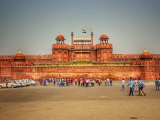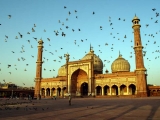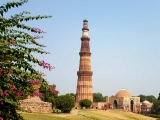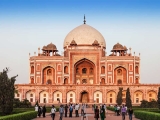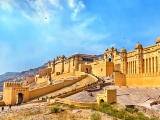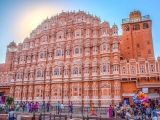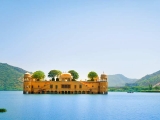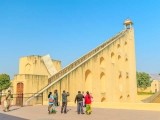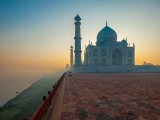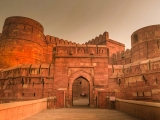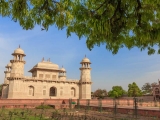Itinerary
1
Arrive Delhi
- Hotel Stay
Upon your arrival in Delhi, the starting point of your Golden Triangle Tour from Delhi, our English-speaking representative will warmly welcome you. You will be transferred to your chosen hotel seamlessly, riding through the bustling Delhi traffic in a comfortable air-conditioned car. Check in at the hotel for an overnight stay.
2
Delhi Sightseeing
- Red Fort
- Jama Masjid
- Qutub Minar
- Humayun’s Tomb
Enjoy a leisurely breakfast before embarking on a day of exploration in Delhi, the vibrant first stop on your Delhi Jaipur Agra Tour. The city boasts lively markets, bustling street life, and fascinating monuments, including:
- Red Fort: A magnificent sandstone monument, locally known as “Lal Quila,” commissioned by Emperor Shah Jahan in 1639. It showcases a blend of Persian, Islamic, and Hindu architectural styles.
- Jama Masjid: India’s largest mosque, built by Shah Jahan between 1644 and 1658, capable of accommodating up to 25,000 people in a single prayer session.
- Qutub Minar: Also known as “The Tower of Victory,” an ancient monument constructed around 1193 by Qutab-ud-din Aibak, surrounded by lush green gardens.
- Humayun’s Tomb: India’s first great dynastic mausoleum, built in 1570 by Mughal emperor Humayun’s wife, Bega Begum, and surrounded by beautiful gardens. Overnight stay in Delhi.
3
Delhi – Jaipur
- Hotel Stay
After breakfast at the hotel, embark on a road trip to Jaipur—planned by one of the Best Tour Operators in India—passing through rural Rajasthan. Enjoy a lunch stop along the way. On reaching the “Pink City,” check in at your selected hotel. The rest of the day is free to relax, followed by an overnight stay.
4
Jaipur Sightseeing
- Amber Fort
- Jal Mahal
- Jantar Mantar
- Hawa Mahal
Start the day with breakfast at the hotel before exploring the city’s prominent attractions:
- Amber Fort (Amer Fort): Perched on a hill overlooking Maota Lake, this hill-top fortress was built by Raja Man Singh I in the 16th century. You can ride an elephant or take a car/jeep to access the fort, which showcases the grandeur of former rulers, including the renowned “Sheesh Mahal” or Hall of Mirrors.
- Jal Mahal: A stunning red sandstone water palace situated in the middle of Man Sagar Lake.
- Jantar Mantar: The largest and best-preserved observatory in India, built by Jai Singh II in the 18th century.
- Hawa Mahal: Also known as the “Palace of the Winds,” this landmark features over 950 small windows on its façade, resembling a beehive. It was built by Maharaja Sawai Pratap Singh in 1799.
- City Palace: A world-famous complex conceived by Sawai Jai Singh II, featuring unique courtyards, gardens, and a museum offering insights into life in Rajasthan. Don’t miss Pitam Nawas Chowk with its four magnificent gates depicting the seasons. Overnight stay in Jaipur.
5
Jaipur – Agra
- Agra Fort
- Taj Mahal
After breakfast, depart for Agra with your driver. Enjoy the interesting sights along the way, and upon arrival, check-in at your hotel. Relax before an evening visit to the Taj Mahal, one of the world’s top landmarks, and a marvel of architecture built by Shah Jahan for his beloved wife, Mumtaz. Overnight stay in Agra.
6
Agra – Delhi and Departure
- Taj Mahal
- Departure
Seize the opportunity to revisit the Taj Mahal at sunrise and witness its magnificence in the gentle morning light. Return to the hotel for breakfast, checkout, and then proceed to Delhi. Your driver will take you to the airport or your chosen hotel if you have onward plans.
Tour Ends
FAQs
1) Do I need a visa to visit India for the Golden Triangle tour?
Most visitors need an India e-Visa, which you apply online at least four days before arrival; print the approval to present with your passport at immigration. Eligible nationalities may choose a thirty-day, one-year, or five-year multiple-entry e-Visa. Ensure your passport has six months’ validity and two blank pages.
2) When is the best season to travel the Golden Triangle?
October to March offers sunny days, blue skies, and comfortable 10-25 °C temperatures, ideal for sightseeing and photography . Early winter festivals—Diwali, Pushkar Camel Fair, Republic Day Parade—add cultural color without oppressive heat.
3) Is the Taj Mahal open every day?
The Taj Mahal is closed to general visitors every Friday for mosque prayers but open Saturday through Thursday from sunrise to sunset, with last entry forty-five minutes before dusk.
